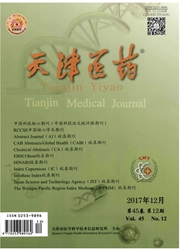

 中文摘要:
中文摘要:
目的:探讨实验性慢性间歇低氧大鼠血压升高与血浆儿茶酚胺、内皮素水平的关系。方法:48只雄性Wistar大鼠随机均分为间歇低氧组和对照组,间歇低氧组大鼠予7h/d间歇低氧处理,分别观察两组大鼠3、6、9周末血压、血浆儿茶酚胺和内皮素-1的水平。结果:间歇低氧组大鼠3、6、9周末血压及血浆肾上腺素、内皮素-1水平均明显高于对照组(均P〈0.01),间歇低氧组大鼠血压与血浆肾上腺素、内皮素-1呈正相关(r分别为0.921和0.804,均P〈0.01)。结论:慢性间歇低氧诱发大鼠血压升高与交感神经活性增强及内皮功能受损有关。
 英文摘要:
英文摘要:
Objective: To observe chronic intermittent hypoxia on the changes of blood pressure and plasma eate cholamines and endothehn-1 (ET-1) in rats, study its mechanism. Methods:Forty eight male Wistar rats were randomly divided into two groups: the intermittent hypoxia group(IH) and the control group. IH rats were subjected to intermittent hypoxia (7 h/d). The levels of blood pressure,plasma catecbolamines and ET-1 for two groups were measured on the end of 3, 6 and 9 weeks after experiment. Results: The levels of systolic blood pressure,plasma epinephrine and ET-1 in IH rats were significantly elevated compared with controls on week 3, 6 and 9 after experiment (P 〈 0.01). Systohc blood pressure was positive correlation with plasma epinephrine and ET-1 in the IH group (r = 0.921,P 〈 0.01;r = 0.804,P 〈 0.01). Conclusion: Chronic intermittent hypoxia can cause a progressive increase in blood pressure. The mechanism is correlated with both sympathetic overactivity and vascular endothelial dysfunction.
 同期刊论文项目
同期刊论文项目
 同项目期刊论文
同项目期刊论文
 期刊信息
期刊信息
